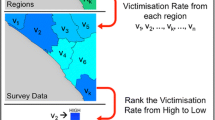Abstract
Objectives
This study aims to examine the association between security cameras in public spaces in Japan with residents’ perceived neighborhood social cohesion and trust.
Methods
The present study used a postal questionnaire mailed to randomly sampled residents aged 20 and 74 years, residing in Ichikawa City, in Chiba Prefecture, Japan. Data from 618 respondents in 39 neighborhoods were used. We used the instrumental variable method in our analyses to strengthen our causal inference. Using probit models, we examined the association between instrumented security camera awareness and perceived neighborhood social cohesion and trust.
Results
Security camera awareness was negatively related to perceived neighborhood cohesion and positively associated with trust in others.
Conclusions
This study demonstrated the potential causal relationship between security cameras and perceptions of communal society; i.e., a positive effect on trust in others and a negative effect on perceived social cohesion. These findings suggest the importance of considering positive and negative social aspects when implementing security camera policies.
Similar content being viewed by others
References
Abe, K. (2004). Everyday policing in Japan: Surveillance, media, government and public opinion. International Sociology, 19, 215–231.
Abe, K. (2006). Technologies of surveillance. Theory, Culture & Society, 23, 265–267.
Abe, K. (2009). The myth of media interactivity: Technology, communications and surveillance in Japan. Theory, Culture & Society, 26, 73–88.
Amemiya, M., Shimada, T., & Takagi, D. (2011). A case study of CCTV cameras installed at public parks and public attitudes toward in Ichikawa City, Chiba Prefecture. Journal of Japanese Institute of Landscape Architecture, 74, 783–788 (in Japanese).
Angrist, J. D., & Pischke, J. S. (2008). Mostly harmless econometrics: An empiricist’s companion. Princeton: Princeton University Press.
Beck, U. (1992). Risk society: Towards a new modernity. London: Sage.
Bennett, T., & Gelsthorpe, L. (1996). Public attitudes towards CCTV (Closed Circuit Television) in public spaces. Studies on Crime and Crime Prevention, 5, 72–90.
Blakely, E. J., & Snyder, M. G. (1999). Fortress America: Gated communities in the United States. Washington: Brookings Institution Press.
Botan, C. (1996). Communication work and electronic surveillance: A model for predicting panoptic effects. Communication Monographs, 63, 293–313.
Cerezo, A. (2013). CCTV and crime displacement: A quasi-experimental evaluation. European Journal of Criminology, 10, 222–236.
Cohen, S. (1972). Folk devils and moral panics. London: MacGibbon and Kee.
Dower, J. W. (1995). Japan in war and peace: Essays on history, culture and race. London: Harper Collins Publishers.
Friedman, B., Kahn, P. H., Hagman, J., Severson, R. L., & Gill, B. (2006). The watcher and the watched: Social judgments about privacy in a public place. Human–Computer Interaction, 21, 235–272.
Gill, M., & Spriggs, A. (2005). Assessing the impact of CCTV. London: Home Office Research, Development and Statistics Directorate.
Gill, M., Bryan, J., & Allen, J. (2007). Public perceptions of CCTV in residential areas: “It is not as good as we thought it would bee”. International Criminal Justice Review, 17, 304–324.
Haraoka, Y., & Tsuburaoka, H. (2019). Kizuna: Instrument of inclusion/exclusion. Journal of Tokyo University of Information Science, 22, 55–66 (in Japanese).
Hino, K., & Amemiya, M. (2009). Desirable surveillance for the security of existing residential areas: Through a questionnaire and direct personal assessment in an area in Chiba. Journal of the City Planning Institute of Japan, 44, 301–306 (in Japanese).
Hino, K., & Terauchi, Y. (2007). Problems and prospects of daily safety in detached housing areas: Through two cases incorporating road safety and crime prevention into planning. Journal of the City Planning Institute of Japan, 42, 697–702 (in Japanese).
Hino, K., Shimada, T., & Hino, A. (2008). Citizens’ attitude to CCTV installed in public places: In the view of who installs where. Reports of the City Planning Institute of Japan, 7, 45–48 (in Japanese).
Honess, T., & Charman, E. (1992). Closed circuit television in public places: Its acceptability and perceived effectiveness. London: Home Office.
Ichikawa Municipal Government (2018). The number of crime in Ichikawa City. Retrieved from http://www.city.ichikawa.lg.jp/res04/1541000001.html. (in Japanese) Accessed 25 July 2019.
Jacobs, J. (1961). The death and life of great American cities. New York: Random House.
Kawachi, I., Takao, S., & Subramanian, S. V. (2013). Global perspectives on social capital and health. New York: Springer.
Kearns, A., & Forrest, R. (2000). Social cohesion and multilevel urban governance. Urban Studies, 37, 995–1017.
Klein, C. (2013). Social capital or social cohesion: What matters for subjective well-being? Social Indicators Research, 110, 891–911.
La Vigne, N. G., & Lowry, S. S. (2011). Evaluation of camera used to prevent crime in commuter parking facilities: A randomized controlled trial. Washington: Urban institute Justice Policy Center.
Low, S. M. (2003). Behind the gates: Life, security, and the pursuit of happiness in fortress America. London: Routledge.
Lyon, D. (2001a). Facing the future: Seeking ethics for everyday surveillance. Ethics and Information Technology, 3, 171–180.
Lyon, D. (2001b). Surveillance society: Monitoring everyday life. Buckingham: Open University Press.
Lyon, D. (2007). Surveillance, security and social sorting: Emerging research priorities. International Criminal Justice Review, 17, 161–170.
Marti, J., Bolibar, M., & Lozares, C. (2017). Network cohesion and social support. Social Networks, 48, 192–201.
Ministry of Justice. (2014). White paper on crime 2014. Tokyo: Ministry of Justice.
Murakami Wood, D. (2012). Cameras in context: A comparison of the place of video surveillance in Japan and Brazil. In A. Doyle, R. Lippert, & D. Lyon (Eds.), Eyes everywhere: The global growth of camera surveillance (pp. 83–99). London: Routledge.
Murakami Wood, D., Lyon, D., & Abe, K. (2007). Surveillance in urban Japan: A critical introduction. Urban Studies, 44, 551–568.
Muranaka, H., Amemiya, M., & Ohyama, T. (2016). Survey and evaluation of large-scale installation of CCTV in public space by local governments. Journal of the City Planning Institute of Japan, 51, 357–364 (in Japanese).
National Police Agency (2018). Police white paper 2018. Retrieved from https://www.npa.go.jp/hakusyo/h30/pdf/03_tokushu.pdf. (in Japanese). Accessed 17 May 2020.
Nieto, M., Johnston-Dodds, K., & Simmons, C. W. (2002). Public and private applications of video surveillance and biometric technologies. Sacramento: California State Library, California Research Bureau.
Ogura, T. (2005). Gurobaruka to kanshi keisatsu kokka eno teiko [Resistance against globalisation and the surveillance/police state]. Tokyo: Kinohanasha (in Japanese).
Piza, E. L., Welsh, B. C., & Farrington, D. P. (2019). CCTV surveillance for crime prevention: A 40-year systematic review with meta-analysis. Criminology & Public Policy, 18, 135–159.
Ratcliffe, J. (2006). Video surveillance of public places. Washington: U.S. Department of Justice, Office of Community Oriented Policing Services.
Ratcliffe, J., Taniguchi, T., & Taylor, R. B. (2009). The crime reduction effects of public CCTV cameras: A multi-method spatial approach. Justice Quarterly, 26, 746–770.
Rogers, W. (1994). Regression standard errors in clustered samples. Stata Technical Bulletin, 3, 19–23.
Saetnan, A. R., Lomell, H. M., & Wiecek, C. (2004). Controlling CCTV in public spaces: Is privacy the (only) issue? Reflections on Norwegian and Danish observations. Surveillance & Society, 2, 396–414.
Sampson, R. J., Raudenbush, S. W., & Earls, F. (1997). Neighborhoods and violent crime: A multilevel study of collective efficacy. Science, 277(5328), 918–924.
Sarno, C., Hough, M., & Bulos, M. (1999). Developing a picture of CCTV in Southwark town centres: Final report. London: South Bank University.
Shimada, T. (2012). Security camera: In preparation for effective installation and operation and social acceptance. Sonpo Yohou Jihou, 251, 20–27 (in Japanese).
Staiger, D. O., & Stock, J. H. (1997). Instrumental variables regression with weak instruments. Econometrica, 65, 557–586.
Tajima, Y., Saito, T., & Yamamoto, H. (2003). Juki-net to kanshi shakai [Juki-net and surveillance society]. Tokyo: Nihon Hyoronsha (in Japanese).
Takagi, D., Ikeda, K., Kobayashi, T., Harihara, M., & Kawachi, I. (2016). The impact of crime on social ties and civic participation. Journal of Community & Applied Social Psychology, 26, 164–178.
Tipton, E. K. (1990). The Japanese police state: The Tokko in interwar Japan. London: Athlone.
Uveda, V. P., Donadello, G., Gasparin, F. M., & Macke, J. (2011). The electronic eyes of the social capital. Signal Processing: An International Journal, 5, 65–79.
Van den Bos, W., Crone, E. A., Meuwese, R., & Guroglu, B. (2018). Social network cohesion in school classes promotes prosocial behavior. PLoS One, 13, e0194656.
Welsh, B. C., & Farrington, D. P. (2009a). Making public places safer: Surveillance and crime prevention. New York: Oxford University Press.
Welsh, B. C., & Farrington, D. P. (2009b). Public area CCTV and crime prevention: An updated systematic review and meta-analysis. Justice Quarterly, 26, 716–745.
Yamagishi, T. (2011). Trust: The evolutionary game of mind and society. New York: Springer.
Yamagishi, T., & Yamagishi, M. (1994). Trust and commitment in the United States and Japan. Motivation and Emotion, 18, 129–166.
Zureik, E. (2007). Surveillance studies: From metaphors to regulation to subjectivity. Contemporary Sociology, 36, 112–115.
Author information
Authors and Affiliations
Corresponding author
Additional information
Publisher’s note
Springer Nature remains neutral with regard to jurisdictional claims in published maps and institutional affiliations.
Rights and permissions
About this article
Cite this article
Takagi, D., Amemiya, M. & Shimada, T. What do security cameras provide for society? The influence of cameras in public spaces in Japan on perceived neighborhood cohesion and trust. J Exp Criminol 18, 129–147 (2022). https://doi.org/10.1007/s11292-020-09437-8
Published:
Issue Date:
DOI: https://doi.org/10.1007/s11292-020-09437-8




